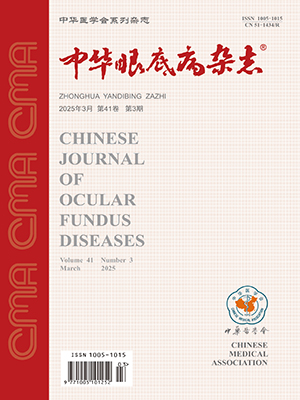Objective To observe the clinical characterisitics of choroidal excavation in the macula.
Methods A total of 22 patients (22 eyes) with choroidal excavation diagnosed by spectral domain high definition optical coherence tomography (HD-OCT) were enrolled in this study. The patients included 12 males (54.50%) and 57 females (45.50%). The age was ranged from 21 to 82 years old, with an average of (41.44±13.17) years. All the patients were affected unilaterally, including 9 right eyes and 13 left eyes. The corrected vision, slit lamp microscope with preset lens, fundus photography, HD-OCT and fluorescence fundus angiography (FFA)were measured for all patients. The clinical characterisitics and concomitant diseases were observed. Seventeen eyes were followed for a period between 3 to 12 months. The lesions change were evaluated by HD-OCT.
Results There were 18 eyes (81.8%) with symptoms of micropsia and metamorphopsia, 4 eyes (18.2%) without symptoms. The corrected vision was ranged from 0.3 to 1.2, 12 eyes (54.54%) with moderate or high myopia. Fundus examination presents yellowish-white exudation in 12 eyes (54.54%), yellowish-white exudation accompanied with hemorrhage in 9 eyes (40.91%), grayish yellow reflex halo in 1 eye (4.55%). HD-OCT showed that the retinal pigment epithelium (RPE) layer was involved in the excavation, and the photoreceptor outer segment and pigment junction (OPR) layer was disappeared in all eyes. The external limiting membrane and the photoreceptor inner segment/outer segment junction layer were preserved in 13 eyes (59.09%) and disappeared in 9 eyes (40.91%). There were 10 eyes (18.18%) with a single lesion, 4 eyes (18.18%) with idiopathic choroidal neovascularization, 4 eyes (18.18%) with punctate inner choroidopathy, 1 eye (4.55%) with polypoidal choroidal vasculopathy, 1 eye (4.55%) with macular preretinal menbrance, 1 eye (4.55%) with central serous chorioretinopathy. FFA showed hypofluorescence in early phase, hyperfluorescence in late phase, without obvious leakage. There was no noticeable changes in size and morphological changes in the follow-up period.
Conclusions Choroidal excavation in the macula occurs mostly in middle-aged people with myopia. It can be associated with many fundus diseases. The excavation is located in RPE layer, and OPR layer disappeared. Choroidal excavation in the macula develops slowly.
Citation:
YaoXue, WeiHua, YuBaohua. Clinical characterisitics of choroidal excavation in the macula. Chinese Journal of Ocular Fundus Diseases, 2014, 30(5): 480-483. doi: 10.3760/cma.j.issn.1005-1015.2014.05.013
Copy
Copyright © the editorial department of Chinese Journal of Ocular Fundus Diseases of West China Medical Publisher. All rights reserved
| 1. |
Wakabayashi Y, Nishimura A, Higashide T, et al. Unilateral choroidal excavation in the macula detected by spectral-domain optical coherence tomography[J]. Acta Ophthalmol, 2010, 88:87-91.
|
| 2. |
Jampol LM, Shankle J, Schroeder R, et al. Diagnostic and therapeutic challenges[J]. Retina, 2006,26:1072-1076.
|
| 3. |
Nair U,Soman M,Ganekai S,et al.Morohological patterns of indirect choroidal rupture on spectral domain optical coherence tomography[J].Clin ophthalmol,2013,7:1503-1509.
|
| 4. |
Srinivasan VJ, Monson BK, Wojtkowski M,et al. Characterization of outer retinal morphology with high-speed, ultrahighresolution optical coherence tomography[J]. Invest Ophthalmol Vis Sci, 2008, 49:1571-1579.
|
| 5. |
陈有信.息肉样脉络膜血管病变:争议、挑战与机遇并存[J]. 中华眼底病杂志,2014,30:227-229.
|
| 6. |
St Martin JM, Rodmon J, Pizzimenti JJ, et al. The"double-layer sign":in vivo imaging of polypoidl vasculopathy[J]. Optom Vis Sci,2013,90:293-300.
|
| 7. |
黎晓新. 眼的解剖和生理[M]//葛坚. 眼科学. 北京:人民卫生出版社,2011:60-117.
|
| 8. |
Yuka W, Akira N, Tomomi H,et al. Unilateral choroidal excavation in the macula detected by spectral-domain optical coherence tomography[J]. Acta Ophthalmol. 2010:88:87-91.
|
- 1. Wakabayashi Y, Nishimura A, Higashide T, et al. Unilateral choroidal excavation in the macula detected by spectral-domain optical coherence tomography[J]. Acta Ophthalmol, 2010, 88:87-91.
- 2. Jampol LM, Shankle J, Schroeder R, et al. Diagnostic and therapeutic challenges[J]. Retina, 2006,26:1072-1076.
- 3. Nair U,Soman M,Ganekai S,et al.Morohological patterns of indirect choroidal rupture on spectral domain optical coherence tomography[J].Clin ophthalmol,2013,7:1503-1509.
- 4. Srinivasan VJ, Monson BK, Wojtkowski M,et al. Characterization of outer retinal morphology with high-speed, ultrahighresolution optical coherence tomography[J]. Invest Ophthalmol Vis Sci, 2008, 49:1571-1579.
- 5. 陈有信.息肉样脉络膜血管病变:争议、挑战与机遇并存[J]. 中华眼底病杂志,2014,30:227-229.
- 6. St Martin JM, Rodmon J, Pizzimenti JJ, et al. The"double-layer sign":in vivo imaging of polypoidl vasculopathy[J]. Optom Vis Sci,2013,90:293-300.
- 7. 黎晓新. 眼的解剖和生理[M]//葛坚. 眼科学. 北京:人民卫生出版社,2011:60-117.
- 8. Yuka W, Akira N, Tomomi H,et al. Unilateral choroidal excavation in the macula detected by spectral-domain optical coherence tomography[J]. Acta Ophthalmol. 2010:88:87-91.




